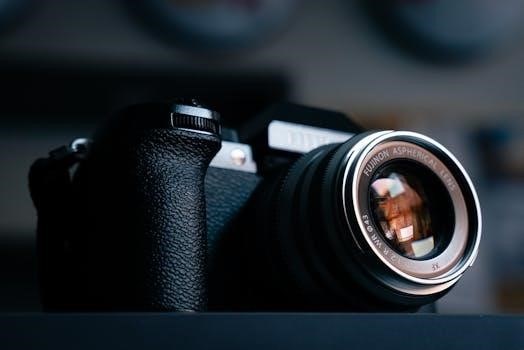Welcome to the comprehensive guide on the Kill A Watt manual. This manual is designed to educate users on effectively monitoring energy consumption. It helps identify energy-efficient appliances and reduce costs. By understanding the manual, users can unlock the device’s full potential and make informed decisions about energy use.
1.1 Overview of the Kill A Watt Device
The Kill A Watt device is a practical tool designed to measure the energy consumption of appliances. It connects directly to devices, providing real-time data on energy use. With a large LCD display, it shows consumption in kilowatt-hours, aligning with utility billing metrics. This device helps users assess appliance efficiency, identify energy-wasting devices, and make informed decisions to reduce energy costs. Its simplicity and accuracy make it a valuable resource for homeowners and businesses aiming to optimize energy use and lower expenses;
1.2 Importance of Understanding the Manual
Understanding the Kill A Watt manual is essential for maximizing the device’s functionality. It provides clear instructions for operating the device, interpreting data, and troubleshooting common issues. The manual explains technical terms and ensures safe, effective use. By familiarizing yourself with the manual, you can accurately measure energy consumption, identify inefficient appliances, and optimize your energy use. It serves as a vital resource for getting the most out of your Kill A Watt device and achieving your energy-saving goals effectively.
1.3 Purpose of the Article
The purpose of this article is to provide a comprehensive guide to understanding and using the Kill A Watt manual effectively. It aims to educate readers on the device’s features, benefits, and proper usage. By exploring the manual in depth, this article helps users optimize energy monitoring, reduce costs, and promote sustainability. Whether you’re a homeowner or an energy-conscious individual, this guide offers practical insights and solutions to maximize the potential of your Kill A Watt device.

What is the Kill A Watt?
The Kill A Watt is a portable energy meter designed to measure electricity usage of household appliances. It helps users assess energy efficiency and reduce consumption effectively.
2.1 Definition and Functionality
The Kill A Watt is a user-friendly energy meter that measures electricity consumption of appliances in kilowatt-hours (kWh), the same unit as utility bills. By plugging an appliance into the device, it provides a clear reading on its energy usage via a large LCD display. This functionality helps users identify energy-efficient devices, monitor power consumption in real-time, and make informed decisions to reduce energy waste and lower utility costs effectively. It’s a practical tool for homeowners and businesses aiming to optimize energy use.
2.2 How It Measures Energy Consumption
The Kill A Watt measures energy consumption by monitoring voltage, current, and power (watts) of connected appliances. It calculates energy use over time, displaying it in kilowatt-hours (kWh), the standard unit for electricity billing. This allows users to track how much energy an appliance consumes, whether it’s in use or standby mode. The device provides accurate, real-time data, helping identify inefficient appliances and optimize energy use effectively. Its straightforward functionality makes it an essential tool for understanding and managing household or office energy consumption.
2.3 Types of Kill A Watt Models
There are several Kill A Watt models available, each offering unique features. The basic Kill A Watt model is ideal for standard energy monitoring, while advanced versions, like the P3 4400, include additional features such as voltage, current, and power factor measurement. Some models also support data logging and wireless connectivity for enhanced monitoring; The P3 4400 stands out for its precision and ability to track detailed energy metrics. These variations cater to different user needs, from basic energy monitoring to advanced energy management.
Key Features of the Kill A Watt
The Kill A Watt features a large LCD display for easy reading, measures energy consumption in kilowatt-hours, and offers compatibility with various appliances. Advanced models like the P3 4400 also include voltage, current, and power factor measurements, providing comprehensive energy monitoring solutions.
3.1 Large LCD Display for Easy Reading
The Kill A Watt’s large LCD display ensures easy readability, even from a distance. It provides clear, real-time data on energy consumption, making it simple to monitor and analyze usage patterns. The display shows measurements in kilowatt-hours, matching your utility bill, and updates continuously. Some models, like the P3 4400, also display voltage and current, offering a comprehensive view of appliance performance. The intuitive design eliminates confusion, allowing users to quickly understand energy usage without technical expertise. This feature is essential for effective energy monitoring and decision-making.
3.2 Measurement by Kilowatt-Hour
The Kill A Watt measures energy consumption in kilowatt-hours (kWh), aligning with how utilities bill electricity. This standard unit makes it easy to understand energy use in familiar terms. By assessing appliances in kWh, users can directly compare their consumption to utility statements. The device provides precise, real-time data, helping identify energy-efficient appliances and reduce waste. This feature ensures accurate tracking of energy use, making it a valuable tool for cost-conscious homeowners and environmentally aware individuals aiming to lower their energy footprint effectively.
3.4 Compatibility with Various Appliances
The Kill A Watt is designed to work with a wide range of household appliances, ensuring versatility in energy monitoring. From refrigerators to televisions, it accommodates various devices, providing consistent measurements. Its universal compatibility allows users to assess energy use across different appliance types, making it a practical tool for comprehensive energy audits. This adaptability ensures that users can monitor and compare the energy efficiency of all their devices, fostering informed decision-making to reduce overall energy consumption and lower utility bills effectively.

Benefits of Using the Kill A Watt
The Kill A Watt helps identify energy-efficient appliances, reduces energy costs, and promotes eco-friendly practices. It empowers users to make informed decisions, lowering utility bills and environmental impact.
4.1 Identifying Energy-Efficient Appliances
The Kill A Watt device is a valuable tool for pinpointing energy-efficient appliances. By measuring power consumption in kilowatt-hours, it helps users identify which devices consume the least energy. This allows for informed decisions on upgrading to more efficient models, reducing overall energy waste. Additionally, it highlights appliances that may be draining power unnecessarily, enabling users to address inefficiencies. Regularly testing appliances ensures optimal performance and supports eco-friendly practices. This feature is essential for both cost savings and environmental sustainability.
4.2 Reducing Energy Costs
Using the Kill A Watt device is an effective way to reduce energy costs. By monitoring appliance consumption, users can identify high-energy devices and adjust usage habits. This tool provides clear insights into power usage, enabling informed decisions to lower utility bills. Regularly assessing energy consumption helps pinpoint areas for improvement, such as replacing inefficient appliances or optimizing usage patterns. Over time, these small changes can lead to significant savings, making the Kill A Watt a practical investment for households aiming to cut energy expenses.
4.3 Environmental Impact of Energy Savings
Reducing energy consumption through the Kill A Watt not only saves money but also benefits the environment. By identifying inefficient appliances, users can lower their carbon footprint. Conserving energy decreases reliance on fossil fuels, reducing greenhouse gas emissions. This contributes to cleaner air and helps combat climate change. Additionally, using renewable energy sources becomes more feasible when overall consumption is minimized. The Kill A Watt encourages sustainable practices, promoting eco-friendly habits and supporting a healthier planet for future generations.

How to Use the Kill A Watt Device
Plug the Kill A Watt into a power outlet, then connect your appliance to the device. It will begin monitoring and displaying energy consumption instantly.
5.1 Connecting Appliances to the Device
To connect appliances, plug the Kill A Watt into a standard power outlet. Next, attach your appliance to the device’s outlet. Ensure compatibility by checking the appliance’s power requirements. Once connected, the device will automatically begin monitoring and displaying energy consumption in kilowatt-hours. This straightforward process allows users to assess energy usage efficiently. Always verify that the appliance is turned on to ensure accurate measurements. Proper connection is essential for reliable data collection and analysis.
5.2 Reading and Interpreting the Display
The Kill A Watt’s LCD display shows energy consumption in kilowatt-hours (kWh), voltage, and current. To interpret, note that kWh measures accumulated energy use over time. The device updates readings in real-time, allowing users to monitor consumption patterns. For example, higher kWh values indicate more energy usage. Use the display to identify energy-hungry appliances or verify efficiency claims. Regularly checking the screen helps track progress in reducing energy waste. This feature empowers users to make informed decisions about their appliance usage and energy savings goals.
5.3 Understanding Kilowatt-Hour Measurements
Kilowatt-hour (kWh) is the standard unit for measuring energy consumption. The Kill A Watt displays energy use in kWh, making it easy to understand your appliance’s consumption over time. One kWh equals 1,000 watts used for one hour. For example, a 100W light bulb running for 10 hours uses 1 kWh. Tracking kWh helps identify energy-hungry appliances and lower utility bills. This measurement aligns with how electricity is billed, providing a clear, relatable way to assess energy usage and optimize efficiency.

Safety Guidelines for Using the Kill A Watt
Always follow safety precautions when using the Kill A Watt. Avoid overloading the device and ensure it is used within the specified voltage range. Keep it away from water to prevent damage or electrical hazards. Regularly inspect the device for any signs of wear or damage before use.
6.1 Precautions Before Use
Before using the Kill A Watt, ensure the device is within its voltage rating and compatible with the appliance. Avoid overloading the device, as it can cause damage. Inspect the device and its components for any signs of wear or damage. Always read the manual carefully to understand proper usage. Ensure the device is placed on a stable surface to prevent accidents. Never use the Kill A Watt near water or in humid environments to avoid electrical hazards. Proper precautions ensure safe and accurate energy measurements.
6.2 Avoiding Overloading the Device
Always check the Kill A Watt’s maximum capacity before connecting appliances. Avoid plugging in high-power devices like space heaters or air conditioners, as they may exceed the device’s limit. Overloading can cause inaccuracies or damage the unit. Use the Kill A Watt for low to medium-power appliances only, ensuring safe and reliable energy measurements. Adhering to these guidelines prevents potential hazards and extends the device’s lifespan. Proper usage ensures accurate readings and maintains the device’s functionality over time.

Troubleshooting Common Issues
Troubleshooting the Kill A Watt involves addressing issues like device malfunction or inaccurate readings. Refer to the manual for solutions and ensure proper usage to resolve problems effectively.
7.1 Device Not Turning On
If your Kill A Watt device fails to turn on, check the power source and ensure all connections are secure. Verify that batteries are fresh or recharge them if necessary. Consult the manual for reset procedures or signs of physical damage. If issues persist, contact customer support or consider replacing the device. Always follow safety guidelines to avoid further complications. Regular maintenance can prevent such issues, ensuring reliable performance for accurate energy measurements and troubleshooting needs.
7.2 Inaccurate Readings and Solutions
Inaccurate readings on your Kill A Watt device can occur due to faulty connections or incorrect settings. Ensure all plugs are securely connected and verify that the device is properly calibrated. If issues persist, reset the device or refer to the manual for troubleshooting steps. In some cases, replacing the device may be necessary. Always follow the manufacturer’s guidelines to maintain accuracy and reliability in energy measurements. Regular checks and proper usage can help prevent such errors and ensure precise results for your energy monitoring needs.
Maintenance Tips for the Kill A Watt
Regular maintenance ensures optimal performance. Clean the LCD display with a soft cloth and avoid harsh chemicals. Store the device in a dry, cool place. Keep the prongs clean to maintain accurate readings and extend the device’s lifespan. Always refer to the manual for specific care instructions to preserve functionality and ensure reliability over time.
8.1 Cleaning the Device
To maintain your Kill A Watt device, regular cleaning is essential. Use a soft, dry cloth, such as microfiber, to gently wipe down the exterior and LCD display. Avoid using liquids or harsh chemicals, as they may damage the electrical components. For the prongs, ensure they are free from dust or debris to maintain accurate readings. Clean the device every few months or as needed to prevent dust buildup and ensure optimal performance. Proper cleaning helps extend the device’s lifespan and reliability.
8.2 Storing the Kill A Watt Properly
Proper storage of the Kill A Watt device is crucial for maintaining its accuracy and longevity. Store it in a cool, dry place away from direct sunlight and moisture. Avoid exposing it to extreme temperatures or physical stress. Use a protective case or pouch to prevent scratches and dust accumulation. Keep it away from children and pets to avoid accidental damage. Proper storage ensures the device remains reliable and ready for use when needed. Always refer to the manual for specific storage recommendations.

The Kill A Watt Manual
The Kill A Watt manual is a comprehensive guide providing detailed information on device operation, technical specifications, and troubleshooting. It’s essential for maximizing the device’s functionality.
9.1 What’s Included in the Manual
The Kill A Watt manual includes detailed setup instructions, safety guidelines, and troubleshooting tips. It also covers technical specifications, measurement accuracy, and how to interpret energy consumption data effectively. Additionally, the manual provides information on compatible appliances and maintenance tips to ensure longevity and optimal performance of the device. This comprehensive guide helps users understand and utilize the Kill A Watt efficiently.
9.2 Understanding Technical Specifications
The manual provides clear explanations of the Kill A Watt’s technical specs, including voltage range, current capacity, and measurement accuracy. It details how the device operates on various appliances and outlines its compatibility with different power sources. Understanding these specs ensures users can safely and effectively monitor their energy usage. The section also covers display functions and data storage capabilities, helping users make the most of the device’s features for accurate energy monitoring and cost savings.
9.3 Navigating the Manual for Beginners
Navigating the Kill A Watt manual is straightforward, even for beginners. The manual is structured to guide users through setup, usage, and troubleshooting. It starts with basic concepts and progresses to advanced features. Clear instructions and diagrams help users understand how to connect appliances and interpret readings. The manual also includes a glossary of terms and frequently asked questions to ensure a smooth learning experience. By following the manual step-by-step, new users can quickly become proficient in using the Kill A Watt device effectively.

Comparing Kill A Watt to Other Energy Meters
The Kill A Watt stands out for its simplicity and accuracy in measuring energy consumption. Unlike other meters, it offers a user-friendly interface and affordable pricing, making it a popular choice for household use. Its ability to measure by kilowatt-hour aligns with utility bills, ensuring clear and relatable energy usage tracking. This makes the Kill A Watt a practical and effective tool for homeowners seeking to monitor and reduce their energy costs. Its ease of use and precise measurements set it apart from more complex or expensive alternatives.
10.1 Features of Alternative Devices
Alternative energy meters often include advanced features like wireless connectivity, smartphone app integration, and detailed data logging. Some models offer multi-appliance monitoring, real-time energy usage tracking, and historical consumption analysis. High-end devices may provide voltage, current, and power factor measurements, catering to industrial or professional needs. These features make them versatile for both household and commercial use, though they can be more complex and expensive than the Kill A Watt. Their enhanced functionality appeals to users requiring deeper energy insights.
10.2 Why Kill A Watt Stands Out
The Kill A Watt distinguishes itself with its simplicity and affordability, making it accessible to homeowners. Unlike more complex meters, it focuses on essential features like kilowatt-hour tracking. Its user-friendly design ensures easy operation without technical expertise. The device is portable and requires no installation, offering instant energy insights. This straightforward approach, combined with accuracy, makes it a preferred choice for those seeking a hassle-free way to monitor energy use without the need for advanced or costly features.

User Reviews and Testimonials
Users praise the Kill A Watt for its effectiveness in identifying energy-hungry appliances. Many find it easy to use for monitoring consumption. Some note the manual’s complexity but appreciate its accuracy.
11.1 Positive Feedback from Users
Many users have shared positive experiences with the Kill A Watt device. They highlight its ease of use and accuracy in measuring energy consumption. Several reviews mention how it helped them identify power-hungry appliances, leading to significant savings on their electricity bills. The large LCD display is frequently praised for its readability. Additionally, users appreciate how the device empowers them to make informed decisions about energy efficiency. Overall, the Kill A Watt is commended for its practicality and effectiveness in everyday use.
11.2 Common Complaints and Solutions
Some users have noted that the Kill A Watt manual can be complex, making it difficult for beginners to understand. Additionally, a few users have reported occasional inaccurate readings, which may stem from improper device calibration or faulty connections. To address this, P3 International advises ensuring the device is used correctly and consulting the troubleshooting section of the manual. For those struggling with the manual, online resources and customer support are available to clarify any confusion. Proper usage and maintenance can resolve most issues effectively.

Frequently Asked Questions
This section addresses common inquiries about the Kill A Watt, offering clear answers to help users understand and utilize the device effectively for energy monitoring.
12.1 Can the Kill A Watt Measure Voltage?
The Kill A Watt primarily measures energy consumption in kilowatt-hours. While it provides voltage readings, its main function is to assess appliance efficiency. For detailed voltage analysis, specialized tools are recommended, ensuring accurate measurements for industrial or advanced applications. This distinction helps users understand the device’s capabilities and limitations, guiding them to the right tools for their specific needs. Always refer to the manual for precise functionality details.
12.2 Is the Device Suitable for Industrial Use?
While the Kill A Watt is excellent for household appliances, it may not be ideal for industrial use due to higher power demands. Industrial settings often require more robust equipment capable of handling larger currents and voltages. The Kill A Watt is designed for standard residential use, ensuring accuracy and safety within its specified limits. For industrial applications, consider heavier-duty energy meters that can handle the increased load and provide more detailed analytics tailored to industrial needs and safety standards.
12.3 Where to Buy Replacement Parts
Replacement parts for the Kill A Watt can be purchased directly from the manufacturer’s official website or through authorized retailers. Online marketplaces like Amazon, eBay, or Walmart often carry compatible components. Local hardware stores specializing in energy management tools may also stock parts. Ensure compatibility by verifying the model number and specifications before making a purchase. Always buy from reputable sources to guarantee authenticity and functionality.
Final Thoughts on the Kill A Watt Manual
The Kill A Watt manual is an essential tool for optimizing energy usage. It empowers users to make informed decisions, reduce costs, and promote sustainability effectively.
13.1 Summary of Key Takeaways
The Kill A Watt manual empowers users to monitor and manage energy consumption effectively. By identifying energy-efficient appliances and reducing costs, it promotes sustainability. The device’s ability to measure in kilowatt-hours aligns with utility billing, making it user-friendly. Its compatibility with various appliances ensures versatility. Regular maintenance and proper storage extend its lifespan. Overall, the Kill A Watt is a practical tool for optimizing energy use and contributing to a greener environment. Users are encouraged to leverage its features for long-term energy savings.
13.2 Encouragement to Use the Device
Using the Kill A Watt is a simple yet powerful step toward understanding and managing your energy consumption. By empowering you to identify energy-efficient appliances and reduce costs, it encourages sustainable practices. The device’s ease of use and precise measurements make it an invaluable tool for optimizing energy use. Embrace the opportunity to contribute to a greener environment while saving money. Start monitoring your energy usage today and enjoy the satisfaction of making informed, eco-friendly decisions for your home or business.



